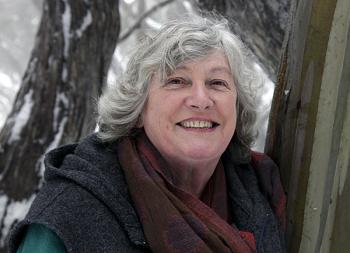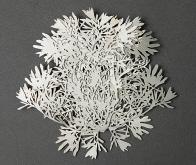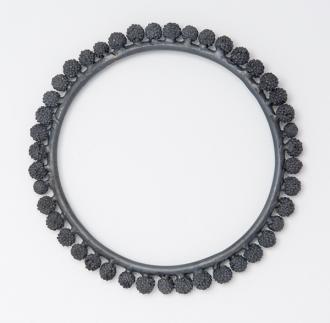
Susan Cummins: Please tell the story of when you knew you wanted to make jewelry.
Marian Hosking: While at high school, I was interested in architecture, Le Corbusier and the Modern movement. I started an architecture degree at Melbourne University, only for a few weeks, in 1967. I believed I could be studying for six years and end up working in a drafting office. I knew it was difficult to build buildings that pushed boundaries, and so I decided to go to art school. My sister had studied painting, and I did not want to study painting. Gold and silversmithing was my choice, so I unenrolled from university and applied to RMIT. I made the right decision for me.

Susan Cummins: Please tell the story of when you knew you wanted to make jewelry.
Marian Hosking: While at high school, I was interested in architecture, Le Corbusier and the Modern movement. I started an architecture degree at Melbourne University, only for a few weeks, in 1967. I believed I could be studying for six years and end up working in a drafting office. I knew it was difficult to build buildings that pushed boundaries, and so I decided to go to art school. My sister had studied painting, and I did not want to study painting. Gold and silversmithing was my choice, so I unenrolled from university and applied to RMIT. I made the right decision for me.

Marian Hosking: I believe I have been closely connected with nature from a very early age. My mother was a conservationist and Australian plant enthusiast. I lived in bush land close to the beach and was allowed to roam from an early age. My very early jewelry was simple and mainly silver, following a philosophy of honesty to materials and silver offered a soft surface suited to subtle shifts in contour. Having lived in a family that frequently went camping, I have continued to return to the national parks in Australia ever since.
In the early 1980s, others often challenged me about using natural references in my work. For me, the selection of specific plants and sometimes birds offered a continuing challenge and interest that I have not yet outgrown.
The title of your exhibition suggests postcards or perhaps souvenirs. What makes jewelry particularly suited to the kinds of messages you are sending in this new work?
Marian Hosking: Jewelry is often dismissed as being overly sentimental, decorative, and romantic. I enjoy these aspects of the objects we select and often gift to others. I revel in the souvenir as an object that has personal and often shared significance. I also enjoy playing with the notion of repetition and the copy.
Do these particular places and landscapes represent a change to the kinds of nature you’ve used before?
Marian Hosking: I am concerned that shifts in popular culture and the political shifts that occur are endangering the areas that previous generations wanted preserved for the enjoyment of current and future generations. I have strong opinions about the fire regimes inflicted on the national parks, about the methods used to control feral animals, and those that allow commercial use of state forests and environments, including our use of the oceans. The environments I explore in small jewelry and vessels are constantly changing, but my jewelry cannot change public opinion or political direction.

Jewelry and nature have been in love for centuries. What is the attraction, for you, that makes nature seem such an obvious subject for jewelry? How do you view yourself as part of a long history of jewelers using nature in their work?
Marian Hosking: Nature is a constructed idea about the world we inhabit. I prefer to start from a known form rather than trying to invent form. I am passionate about making and the environment and am pleased to have had the opportunity to combine both my passions for more than 40 years. When early European settlers found gold in Australia the 1850s, people flocked to the gold fields, and some very interesting pieces of jewelry were made incorporating some of the rich finds. Some depicted the diverse flora of Australia as a souvenir and commemoration of the gold discovered in Australia.

Marian Hosking: Specific plants and sometimes birds are usually the starting point for my pieces. These, and in fact, nature and wilderness have varied readings depending on the prior knowledge of the viewer. Place and identity underpin my work, and I enjoy finding ways to allude to especially familiar plants in less familiar ways.
Are there particular jewelry forms that are more suited to carrying the motifs (and meanings) that are important to you?
Marian Hosking: I am happy working within certain constraints of jewelry. I often use silver. I like making rings, bracelets, and neckpieces. I do not have pierced ears, so I avoid earrings. I am happy to mostly make brooches, which can be associated with badges of power and identity.
Do you collect specimens? Do drawings or photographs? Of plants and birds?
Marian Hosking: I do, unfortunately, collect not only specimens but also examples of souvenirs and other items manmade and natural. I say “unfortunately” because I accumulate too much. I also take photographs and have since I was eight or nine, so again, I have too many boxes of photographs. I do draw and make notes and always have one or two notebooks with me, often a camera, and a plastic bag or container to put things in.


Tell us about the process of making these low-relief brooches.
Marian Hosking: My making technique takes a few paths. I spend a lot of time thinking, searching, and selecting. I have been trained not to disturb or pick plants and shells in national parks, however I do sometimes take a very small sample, which I may photograph, photocopy, draw, or press. My work is graphic, and low relief is something I feel silver is well suited to. I have used various methods to depict plants: saw-piercing sheet silver and overlapping sheets; drilling lots of holes; using a now-obsolete printing technique (a “nylo print”); and direct mould making using a two-part silicon compound that I can no longer purchase.
Do you make components and play around with them to create final compositions, or do you have a very clear idea of what a piece will look like before you start making it?
Marian Hosking: Usually, I have a clear idea of what I am going to make, and sometimes I make drawings. I also learn along the way by making and trying different things. Sometimes, when I am playing with rejected elements or close to a deadline, ideas and other possibilities spring up that I may try out and include or set aside until I have more time. I have been collecting pieces of weathered timber and mulga souvenir pieces for years. I used some of the mulga pieces and made silver lid brooches for the exhibition Marian Hosking-vessels, Laura Deakin-jewellery at Gallery Ra in Amsterdam. This year, I shaped some weathered wood for the greetings from … exhibition at Gallery Funaki. I shall continue to work with wood, silver, and porcelain. I like these materials. I used them for a piece called Clearing, which won The Colin and Cecily Contemporary Design Award at the National Gallery of Victoria 12 months ago. This is an example of the drilled silver using a photocopy.

You make jewelry and vessels. What is the connection between these different kinds of objects?
Marian Hosking: I originally trained in both jewelry and silversmithing and have continued to make vessels and jewelry. I enjoy the different challenges and associations that are inherent to objects we wear and objects we may hold and look at. I am continually learning, and by working sometimes on a larger scale, I am challenged in different ways. My work switches between objects and wearable.
Do you have a book to recommend?
Marian Hosking: I particularly enjoyed The Snoring Bird: My Family’s Journey through a Century of Biology by Bernd Heinrich. “The remarkable story of Bernd Heinrich’s father’s life, his family’s past, and how the forces of history and nature have shaped his own life.” Good Reads
Thank you.




